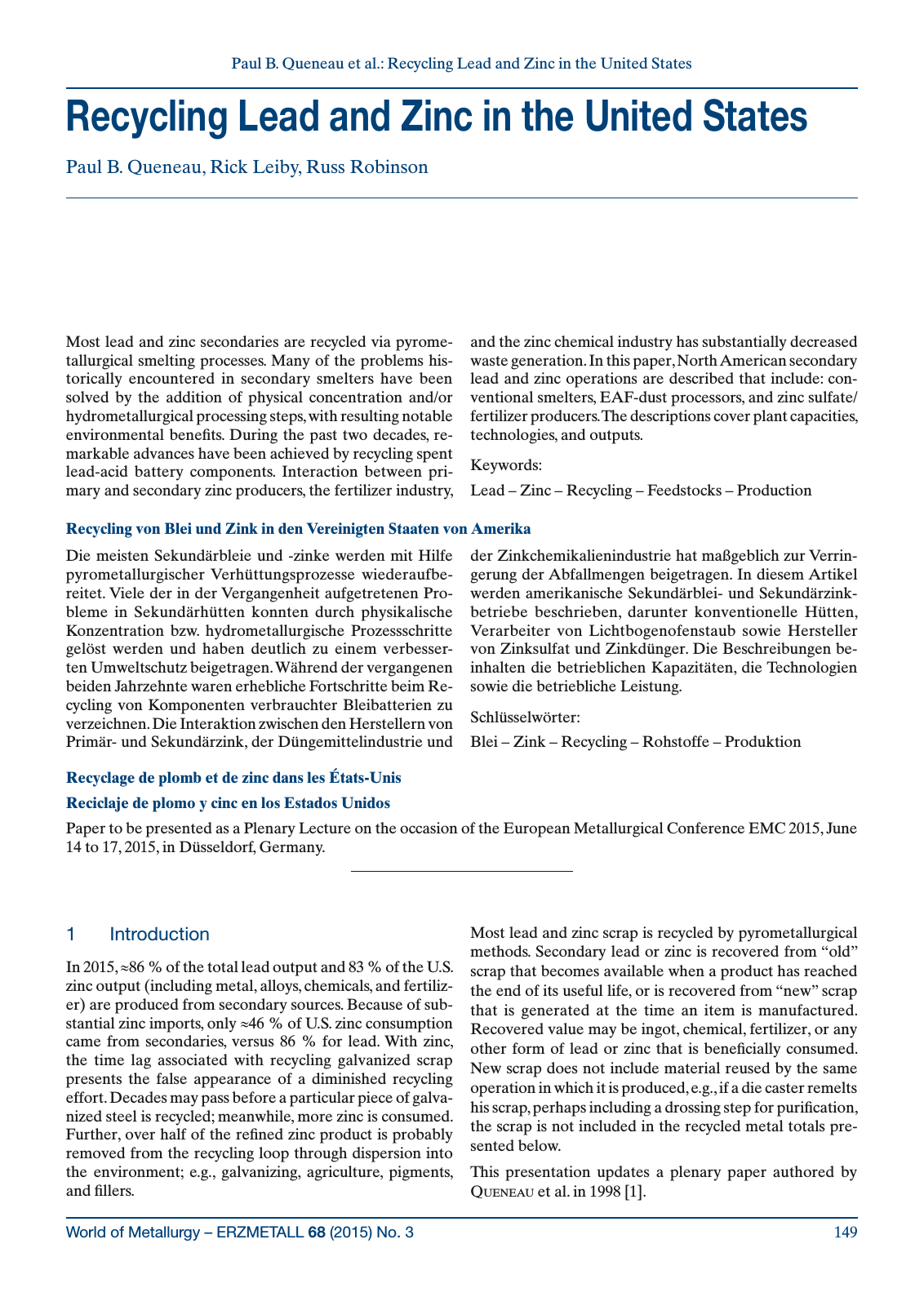World of Metallurgy ERZMETALL 68 2015 No 3 149 Paul B Queneau et al Recycling Lead and Zinc in the United States 1 Introduction In 2015 86 of the total lead output and 83 of the U S zinc output including metal alloys chemicals and fertiliz er are produced from secondary sources Because of sub stantial zinc imports only 46 of U S zinc consumption came from secondaries versus 86 for lead With zinc the time lag associated with recycling galvanized scrap presents the false appearance of a diminished recycling effort Decades may pass before a particular piece of galva nized steel is recycled meanwhile more zinc is consumed Further over half of the refined zinc product is probably removed from the recycling loop through dispersion into the environment e g galvanizing agriculture pigments and fillers Recycling Lead and Zinc in the United States Paul B Queneau Rick Leiby Russ Robinson Most lead and zinc secondaries are recycled via pyrome tallurgical smelting processes Many of the problems his torically encountered in secondary smelters have been solved by the addition of physical concentration and or hydrometallurgical processing steps with resulting notable environmental benefits During the past two decades re markable advances have been achieved by recycling spent lead acid battery components Interaction between pri mary and secondary zinc producers the fertilizer industry and the zinc chemical industry has substantially decreased waste generation In this paper North American secondary lead and zinc operations are described that include con ventional smelters EAF dust processors and zinc sulfate fertilizer producers The descriptions cover plant capacities technologies and outputs Keywords Lead Zinc Recycling Feedstocks Production Recyclage de plomb et de zinc dans les États Unis Reciclaje de plomo y cinc en los Estados Unidos Paper to be presented as a Plenary Lecture on the occasion of the European Metallurgical Conference EMC 2015 June 14 to 17 2015 in Düsseldorf Germany Most lead and zinc scrap is recycled by pyrometallurgical methods Secondary lead or zinc is recovered from old scrap that becomes available when a product has reached the end of its useful life or is recovered from new scrap that is generated at the time an item is manufactured Recovered value may be ingot chemical fertilizer or any other form of lead or zinc that is beneficially consumed New scrap does not include material reused by the same operation in which it is produced e g if a die caster remelts his scrap perhaps including a drossing step for purification the scrap is not included in the recycled metal totals pre sented below This presentation updates a plenary paper authored by Queneau et al in 1998 1 Schlüsselwörter Blei Zink Recycling Rohstoffe Produktion Recycling von Blei und Zink in den Vereinigten Staaten von Amerika Die meisten Sekundärbleie und zinke werden mit Hilfe pyrometallurgischer Verhüttungsprozesse wiederaufbe reitet Viele der in der Vergangenheit aufgetretenen Pro bleme in Sekundärhütten konnten durch physikalische Konzentration bzw hydrometallurgische Prozessschritte gelöst werden und haben deutlich zu einem verbesser ten Umweltschutz beigetragen Während der vergangenen beiden Jahrzehnte waren erhebliche Fortschritte beim Re cycling von Komponenten verbrauchter Bleibatterien zu verzeichnen Die Interaktion zwischen den Herstellern von Primär und Sekundärzink der Düngemittelindustrie und der Zinkchemikalienindustrie hat maßgeblich zur Verrin gerung der Abfallmengen beigetragen In diesem Artikel werden amerikanische Sekundärblei und Sekundärzink betriebe beschrieben darunter konventionelle Hütten Verarbeiter von Lichtbogenofenstaub sowie Hersteller von Zinksulfat und Zinkdünger Die Beschreibungen be inhalten die betrieblichen Kapazitäten die Technologien sowie die betriebliche Leistung

Hinweis: Dies ist eine maschinenlesbare No-Flash Ansicht.
Klicken Sie hier um zur Online-Version zu gelangen.
Klicken Sie hier um zur Online-Version zu gelangen.